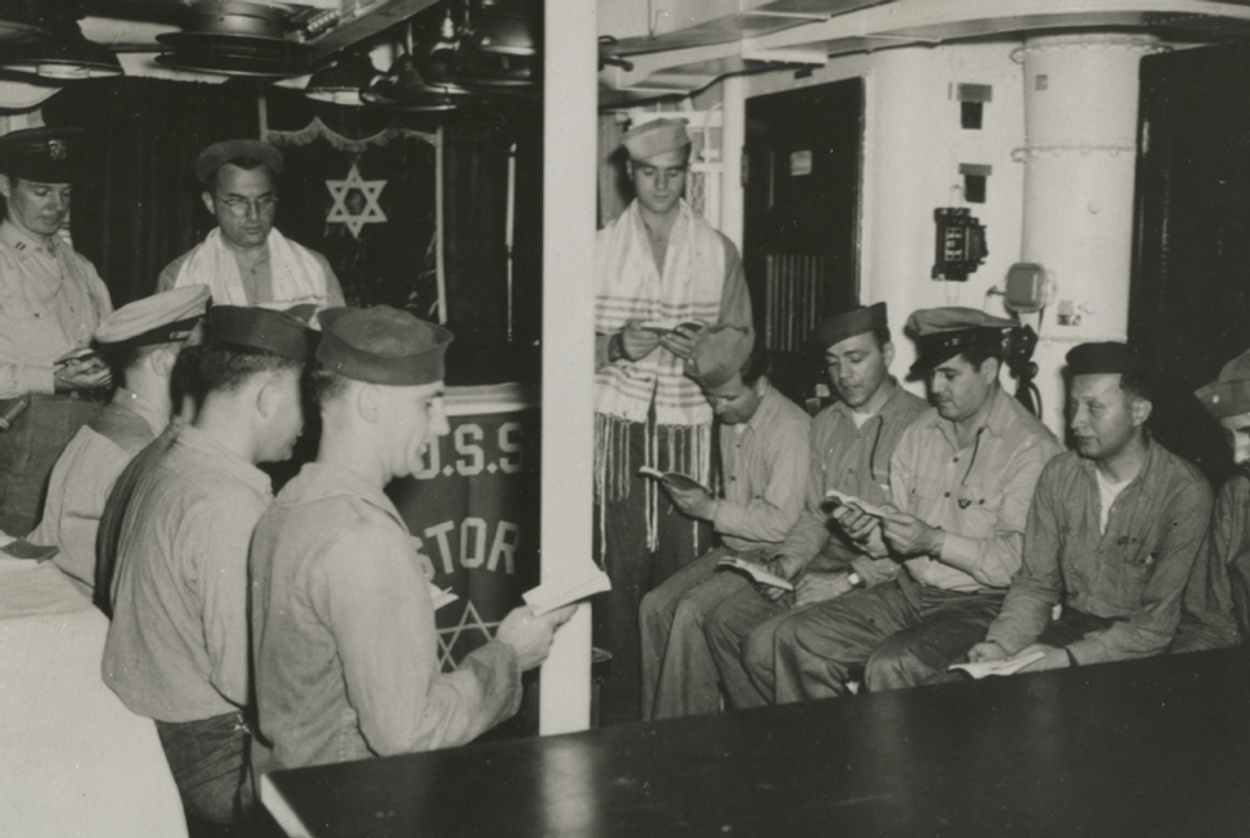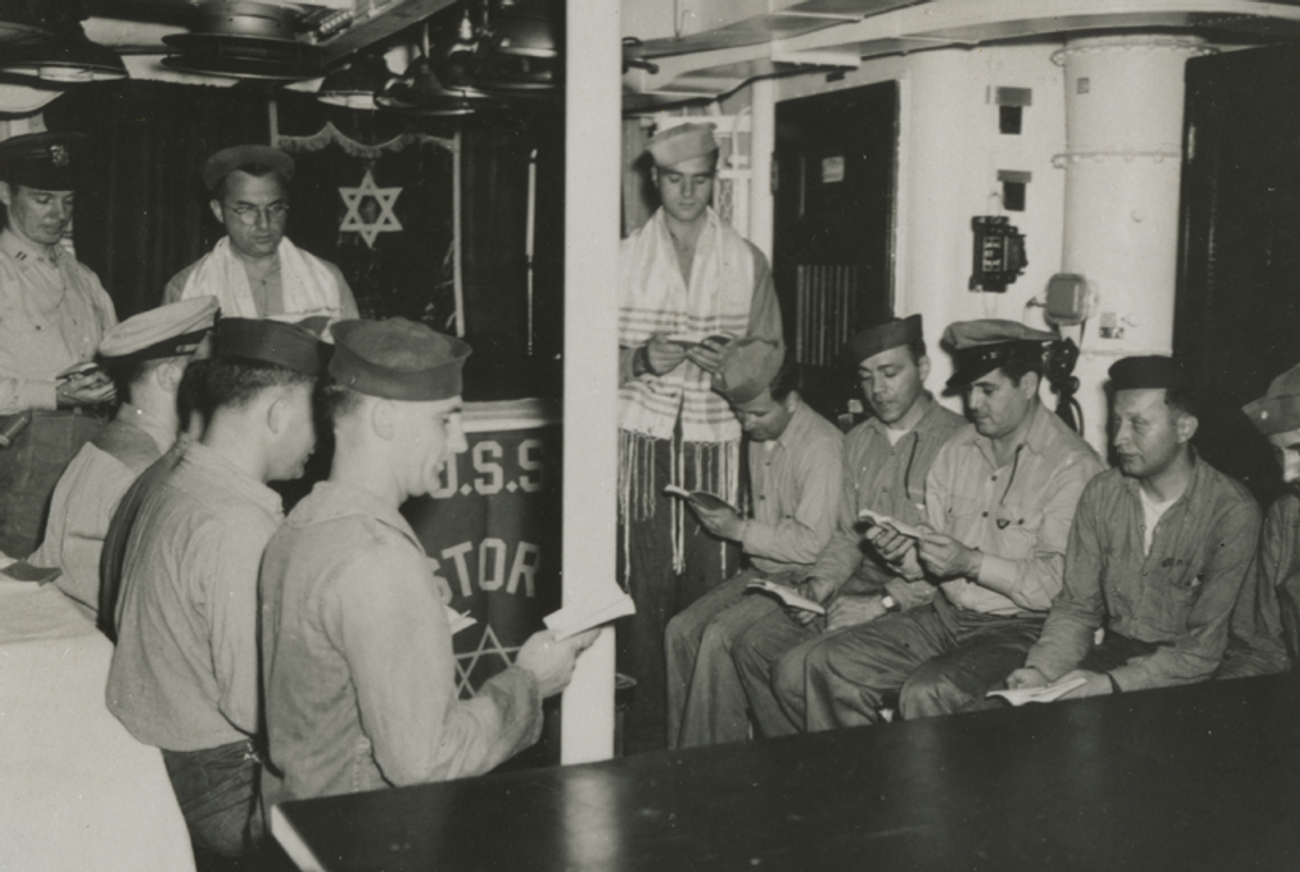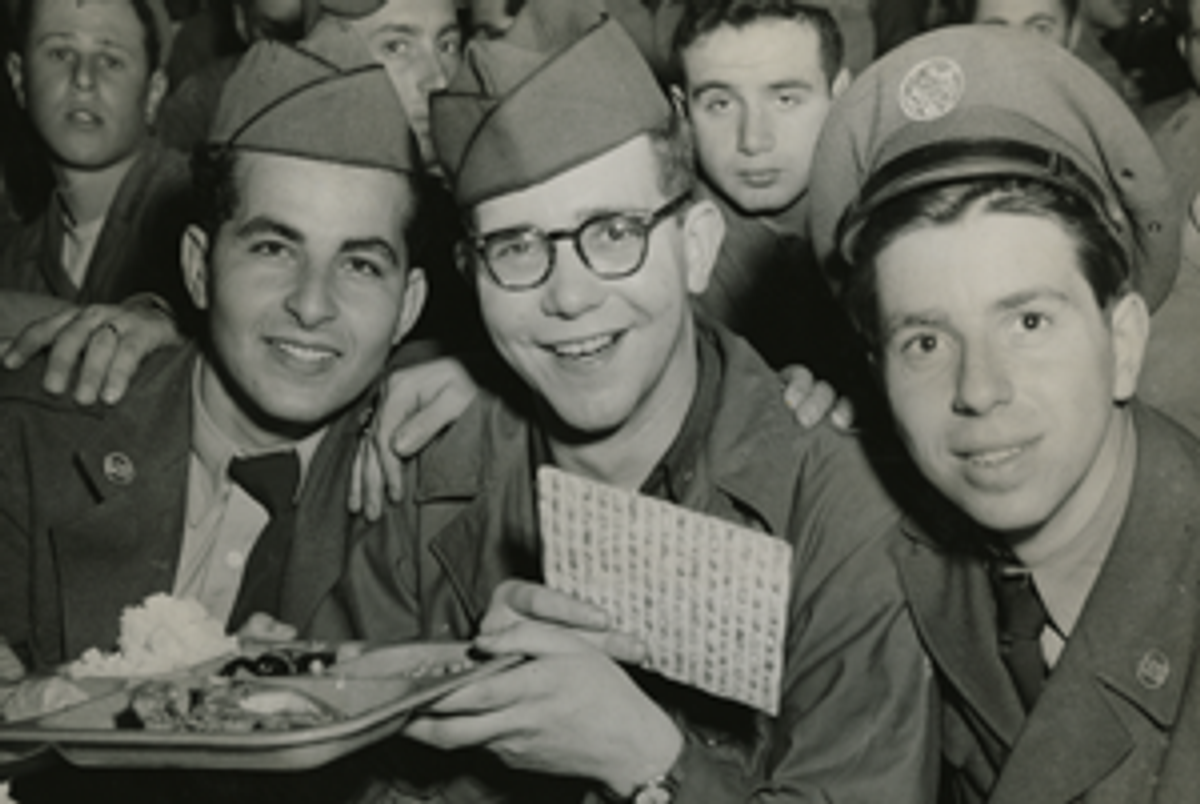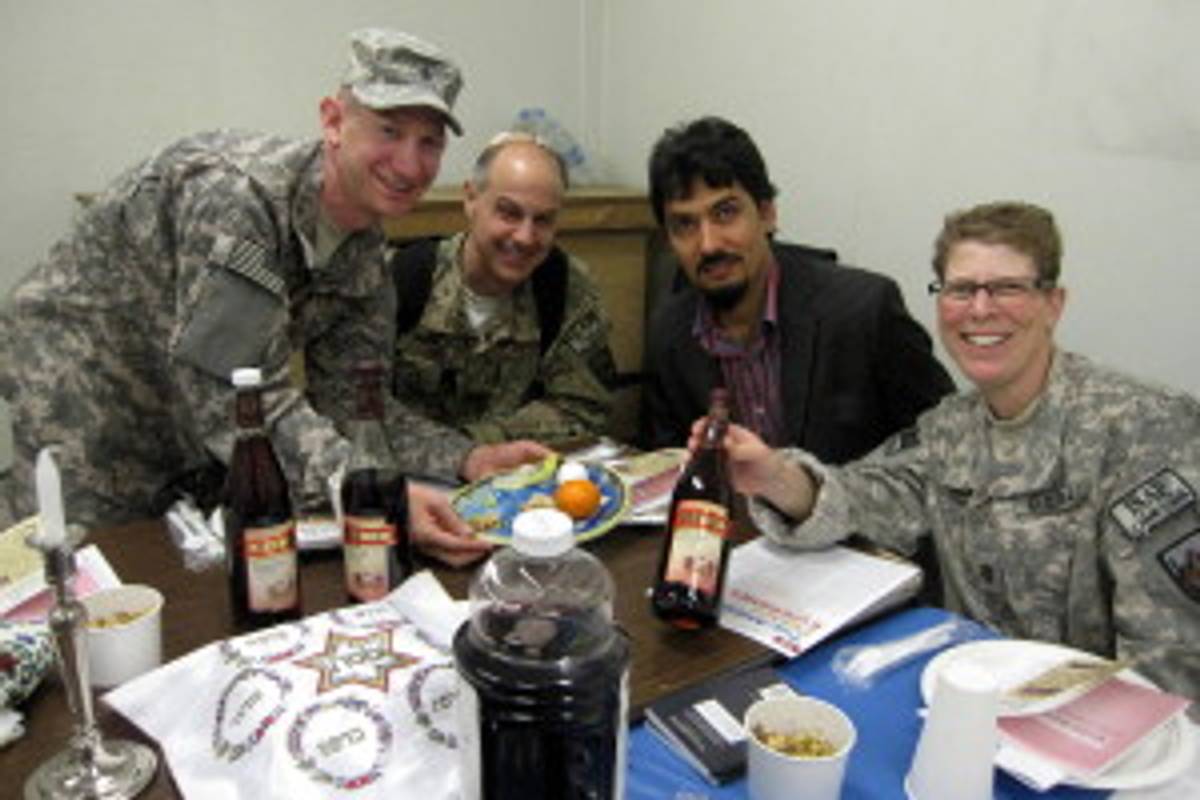Seders in Uniform: How American Troops Celebrated Passover During WWII
Whether in the mess hall or on a battleship, Jewish soldiers stationed all over the world still sang the Four Questions and ate matzo




“Lettuce au charoses.” “Kneidlach or borscht a la Sgt. Weinstein.” “Consommè [sic—the accent points the wrong way!] avec Knadlach.” “Palestine wine.” “Roast Beef Ala Yomtov.” “Iced Coca-Cola.”
These were some of the dishes enjoyed by Jewish members of the military at their Seders in both European and Pacific theaters of war 70 years ago. The American Jewish Historical Society at the Center for Jewish History has a file full of yellowing menus, programs, and homemade haggadot for these celebrations of freedom; they make fascinating reading, a lens through which to appreciate American Jews’ culinary and military past.
While researching a different story at the Center, I stumbled on this file and wound up so enthralled that I scrapped my original column idea to focus on this instead. Who were these American soldiers, noshing on matzo-ball soup in strange lands, sometimes near active fighting? Who organized these Seders? Who did the cooking? It was time to research.
According to the lively website Jews in Green, Jews served in WWII in numbers much higher than our representation in the general population; by some estimates, 4 to 5 percent of U.S. soldiers were Jews at a time when we constituted less than 2 percent of the population. And the significance of fighting for others’ liberty during their own celebration of freedom clearly wasn’t lost on them.
A program from the Air Force Theater in Pisa began with a prayer, “May we be imbued with a deep sense of our duty as free men; and, as we gather here tonight in brotherly reunion, may we be mindful of those who still dwell in the house of bondage and eat the bread of affliction. Let us pray that the day be not far off when the whole world will be liberated from the forces of tyranny, injustice, inequality, and war.” It concludes with the Shehechiyanu prayer in Hebrew.
Some of these Seder programs were informal, handwritten, mimeographed affairs riddled with spelling errors (“HorseRaddish”); some were beautifully printed on heavy, textured paper. Most were similar in content: a cover indicating the place and time—with the year of both the Gregorian (1944 or 1945) and Hebrew (5704 or 5705) calendar, and the time (always in military time, sometimes at the elegantly late 2200 hours). There were lists of the order of events (seder literally means “order”) and the dishes to be served, almost always concluding in “Afikomon.”
Many programs proudly told us who did what and who cooked what: At a Seder in Accra in what later became Ghana, the Four Questions were recited in Hebrew by Pvt. Joseph L. Joldoff and in English by Pfc. Dorothy Steinberg—apparently the youngest soldiers present. A 1945 program from New Delhi, featuring “Bombay Matzos” and “Beef Strokanoff” credited the food to the glamorous-sounding “Madame Luba Ruperti.” (Madame Ruperti’s life was as colorful as her name; three years before the Seder, she’d survived the Japanese sinking off the coast of Indonesia of the S.S. Kuala, a coastal vessel that departed Singapore full of women and children, most of whom died. After three hours in the water—“My fat be blessed for that!” she told a reporter—Madame Ruperti managed to swim to nearby Pom Pong Island, then eventually made her way to India, where she cooked for thousands of U.S. troops, returning to Singapore after the war.)
The food at these Seders was usually a mix of haimishe Eastern-European Jewish and fancy French-ish; French meant cosmopolitan in those days. There was a lot of “compote.” A few menus showed the influence of the cultures the soldiers were stationed in: The Seder at the Imperial Hotel in New Delhi featured “Beckti Farci a la Juife” (presumably that refers to Bhekti, the Bengali word for barramundi; “a la Juife” probably refers to a gefilte-ish preparation). Soldiers in Hawaii had fresh pineapple for dessert. Kashrut was a secondary concern: “For those observing the Dietary laws Tuna fish will be served in place of chicken,” a menu from Rome noted. One could see evidence of thrift: In New Delhi, you could have gefilte fish or matzo balls, but not both. And military comportment was expected; a menu from “liberated Italy” warned in small print: “Guests will kindly observe the regulation number of 4 cups of wine at the Seder.”
On some programs, the final page was used to collect autographs from those in attendance. On others there were address lines so that soldiers could send their families evidence that they were alive and managed to ingest some matzo, even in wartime. (“Mail a copy of the program Home to reassure the folks,” one program explicitly urged.) Some of the menus in the American Jewish Historical Society’s collection bear faded stamps indicating that they’d passed the field censors.

In most cases, the ritual foods and support for these events came from the National Jewish Welfare Board, an organization formed in 1917, three days after the United States declared war on Germany during WWI. It continued to serve Jews in the military during the Korean and Vietnam wars and still does so today by training chaplains and providing help to soldiers, military families, and patients in V.A. hospitals. (The first Jewish chaplain, Jacob Frankel, predates the JWB, however; he was appointed by Abraham Lincoln in 1864.)
Sometimes our soldiers didn’t know precisely where they were celebrating: Haggadot were labeled “Passover on the high seas,” “somewhere in France,” and “somewhere in Italy.” One from a Naval Seder in San Juan, Puerto Rico, took a jokey tone: It came with a page of newspaper, typeset in the style of the New York Times, with the headline “Amphibious Crossing of the Red Sea Outmaneuvered the First Pharaoh.” More seriously, it also contained a letter from a non-Jewish commanding officer, noting, “Especially timely is your celebration this year, preceding as it does the dawn of a new day for the liberated peoples of Europe and the promise of peace to the world. We pray that the day may not be distant when the Pharaoh of our time will be engulfed in the seas of retribution that are closing in upon him.”

Nowadays, Jews seem not to serve in the military in large numbers (though it’s hard to know for sure how many there are, since many in today’s war zones don’t want to reveal their religion), but they still celebrate Passover in the field. David Frommer, the first cantor to serve as chaplain in the U.S. military, has written several gorgeous pieces for Tablet, including one about observing Shavuot and Memorial Day in Kuwait in 2012. He provided us with a picture of a Seder he led in Afghanistan in 2012.
Jewish soldiers today still deserve our support and thanks. You can buy them Passover meals and care packages through the JWB ($1,000 pays for a Seder for an entire base!) or create your own military-oriented mitzvah project through KosherTroops.com.
Check out a slideshow of World War II military Seder programs, above left, co-presented by Tablet in partnership with the American Jewish Historical Society and the Center for Jewish History.
Marjorie Ingall is a former columnist for Tablet, the author of Mamaleh Knows Best, and a frequent contributor to the New York Times Book Review.